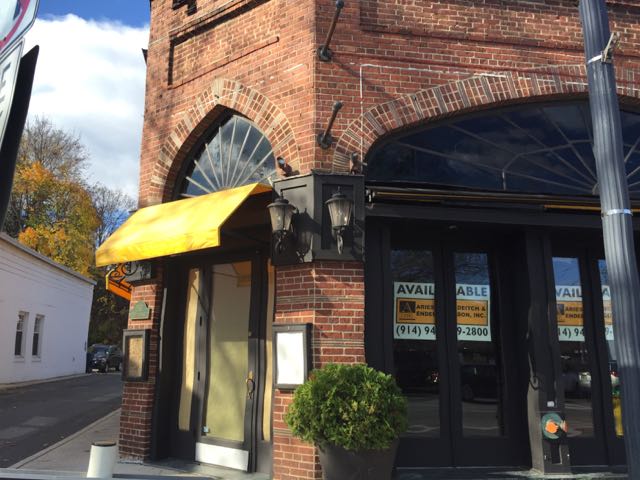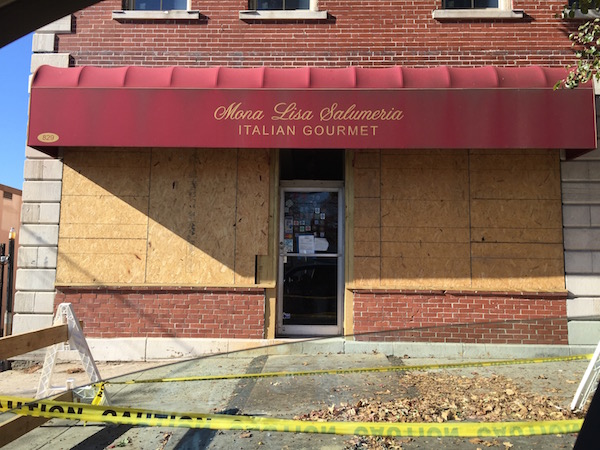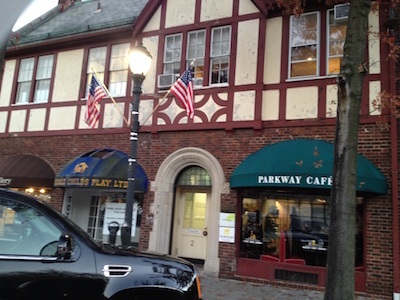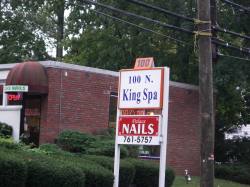League Spotlights NYS "LLC Loophole"
- Details
- Written by: Joanne Wallenstein
- Hits: 5374
 This article was submitted for publication by Mary Beth Evans, Joan Taback Frankle, Joan Mazur and Deb Morel of the League of Women Voters of Scarsdale:
This article was submitted for publication by Mary Beth Evans, Joan Taback Frankle, Joan Mazur and Deb Morel of the League of Women Voters of Scarsdale:
Why have New York campaign finance laws been called "some of the most porous" in the nation (New York Times, Nov. 4, 2014)?
In large part due to New York's infamous "LLC loophole," said Brent Ferguson, Counsel at the Brennan Center for Justice at New York University School of Law, a not-for-profit, non-partisan public policy and law institute that focuses on issues of democracy and justice.
Ferguson was the guest speaker at the League of Women Voters of the Rivertowns "Money in Politics" breakfast event held November 12th at Tarrytown's El Dorado Diner; and, while the audience ate scrambled eggs and toast that morning, he deftly unscrambled one of the more confounding quirks of New York campaign finance law.
State campaign finance law was already on the books when limited liability companies (LLCs) were first allowed to exist in New York in 1994, explained Ferguson. An LLC is hybrid business entity with the liability protection of a corporation and the "pass-through" income taxation of a partnership or sole proprietorship, which allows individual owners to avoid paying double income taxes. In 1996, the state Board of Elections (BOE) ruled that LLCs are the same as individuals for purposes of campaign finance laws.
Ever since, LLCs have become major players in New York state elections. As individuals they are allowed to contribute to statewide candidates in an amount greater than ten times that of corporations, which are limited by law to $5,000 per candidate per calendar year. In the current campaign cycle of primary and general elections, each LLC is now able to contribute to up to $65,000 per statewide candidate. Moreover, noted Ferguson, there is nothing to stop someone "controlling, say, ten LLCs from writing ten checks totaling $650,000 to the same candidate."
Contrary to federal and New York City regulators, who have either banned LLC contributions or now factor them in with individual donation limits, the bipartisan, 4-member (2 Democrat, 2 Republican) New York State BOE has not rescinded its 1996 decision. According to Ferguson, this past April the BOE had a chance to close the "LLC Loophole" by treating LLCs as corporations or partnerships but remained deadlocked 2-2, with the 2 Republicans opposing the change.
LLC Litigation
In July the Brennan Center for Justice and the law firm of Emery Celli Brinckerhoff & Abady LLP filed suit against the BOE on behalf of several former and current State legislators from both political parties. According to the suit, "An LLC is a classic 'legal fiction'" with "virtually none of the characteristics of individual people acting in the political arena."
The suit argues that the "LLC Loophole" violates "the purpose and spirit" of New York's Election Law, which is "to prevent the reality and appearance of quid pro quo corruption." Among the list of evidence that the "LLC Loophole" is "consistently abused" and helps "to facilitate the larger pay-to-play culture" in Albany, the petition cites the following:
• LLCs contributed more than $54.2 million to candidates, parties, and traditional political action committees between 2011 and 2014;
• In 2014 alone, LLCs gave over $19 million, a greater than 300% increase over the amount given by LLCs in 2002;"
• One real estate developer reportedly used 27 LLCs to contribute over $4.3million in 2013 and 2014; and
• A single telecommunications provider reportedly used eight LLCs to give $1.5 million between 2005 and 2013, including $190,000 to one candidate in a single day.
The true source of many contributions via LLCs can be difficult to ascertain. As the Brennan Center notes in its petition, many LLCs have "vague names with little connection to their actual operators" and "a significant number of LLC contributions appear to originate from a small number of wealthy individuals who contribute through multiple LLCs," whose members are "not subject to meaningful disclosure in many instances."
Effect on Democracy
Ferguson stated that "LLC Loophole" provides perspective on what's happening throughout the country at the national level. He compared the use of money in New York elections to the 2016 presidential race, citing a recent report that only 158 of the nation's roughly 120 million families have contributed nearly half the funds raised so far by the 2016 presidential candidates (New York Times, October 11, 2015). Just as the "LLC Loophole" in New York is being used to evade disclosure and exceed campaign funding limits, recent Supreme Court rulings, including Citizens United v. FEC (2010) and McCutcheon v. FEC (2014), have allowed outside groups to make unlimited contributions to national candidates via "SuperPacs" – much of it so-called "dark" money because the true source is not disclosed.
"Why is this a problem for our democracy?" Ferguson asked rhetorically.
Besides "turning the tide of elections by giving some candidates an unfair advantage," he stated that one of the biggest problems is "what happens after the election, with the wealthy few seeing their policy preferences enacted." According to Ferguson this problem also has to do with "the type of people getting elected." When the system "discourages people without connections to the wealthy, only a certain subset of people get elected, which means only a certain subset of policies get enacted."
Cause for Optimism
Ferguson said the press "does not pay enough attention" and faulted journalists for treating the flow of money in politics as "business as usual." He noted that cynicism is pervasive, citing national polling results indicating 80-90% of Americans want the system to change but "almost the same number think nothing can be done."
Nonetheless, Ferguson remains optimistic. He said there is cause for hope at the national level in "the groundswell of bipartisan support" for a Constitutional Amendment to address what the Brennan Center refers to as "the tidal wave of money threatening to swamp our political process."
The Brennan Center supports an amendment; however, Ferguson noted, even if an amendment were to pass, both state and federal lawmakers "still must pass laws to fill the void," and both the current Congress and the New York State Legislature "lack the political will" to make such changes. As Blair Horner, the legislative director for the New York Public Interest Research Group put it in a 2010 WNYC radio interview, "There's a lot of rhetoric for reform in Albany, but the reality is, political parties and many candidates are addicted to the mother lode of money that comes through the LLC."
Still, Ferguson asserted, "much can be done and historically has been done" to stop the unregulated flow of money in politics.
Promising Public Finance Programs
Ferguson pointed to New York City's successful public financing program, stating that the city's voluntary small-donor matching fund system has limited the size of campaign contributions and expenditures and improved disclosure. Moreover, it has allowed a "more diverse" array of candidates with a greater incentive to reach out to "a more diverse set of ordinary voters". Ferguson added that Brennan Center helped to write a bill last year that "almost passed" and would have enacted a public finance system statewide, which neighboring Connecticut already has in place.
Ferguson also touted Seattle's newly enacted alternative method of public financing in which city residents do not have to spend their own money. Instead, the city government will issue four $25 vouchers to each registered voter, who can then donate the funds to the candidates of their choice.
Finally, Ferguson expressed hope that the Brennan Center's LLC litigation will result in the closure of New York's "LLC Loophole," with "a new rule in place by the 2016 election."
Submitted by:
Mary Beth Evans: Money in Politics Chair
Joan Taback Frankle: Secretary
Joan Mazur: Money in Politics Committee member
Deb Morel: President of the League of Women Voters of Scarsdale.
Retail Closings and Openings
- Details
- Written by: Joanne Wallenstein
- Hits: 8048
 It's one step forward two steps back for retail stores and restaurants in Scarsdale and Hartsdale. Scarsdale Village continues to have vacancies, most visibly on Harwood Court, Spencer Place and Boniface Circle. A long time tenant on Spencer Place complained that the landlord is not aggressive about seeking out new tenants to fill the stores, making it more difficult for those who remain in business to draw customers. He also said that the buildings are not being well maintained and pointed out facades with peeling paint.
It's one step forward two steps back for retail stores and restaurants in Scarsdale and Hartsdale. Scarsdale Village continues to have vacancies, most visibly on Harwood Court, Spencer Place and Boniface Circle. A long time tenant on Spencer Place complained that the landlord is not aggressive about seeking out new tenants to fill the stores, making it more difficult for those who remain in business to draw customers. He also said that the buildings are not being well maintained and pointed out facades with peeling paint.
In Eastchester we noticed that Italian delicatessen Mona Lisa Salumeria remains closed after fire damaged the store in March. The front windows are boarded up. A commenter on Yelp says that Mona Lisa will reopen shortly, but for now it's looking dark.
delicatessen Mona Lisa Salumeria remains closed after fire damaged the store in March. The front windows are boarded up. A commenter on Yelp says that Mona Lisa will reopen shortly, but for now it's looking dark.
Popular bar and restaurant Harry's of Hartsdale closed in August, or "retired" after "sixteen successful years of gastronomic delight and good cheer" according to their website. There are now signs in the windows of the vacant restaurant advertising for new tenants.
 And if you head out to Chef Central in preparation for your Thanksgiving dinner, you'll find that they have discounted their merchandise in anticipation of a January 2016 closing. They moved from Central Avenue to 15,000 square feet in the Crossroads Shopping Center on Route 119 a few years ago and perhaps their customers did not follow them. It may also have been too close to Bed, Bath and Beyond where similar merchandise can be found on Route 119.
And if you head out to Chef Central in preparation for your Thanksgiving dinner, you'll find that they have discounted their merchandise in anticipation of a January 2016 closing. They moved from Central Avenue to 15,000 square feet in the Crossroads Shopping Center on Route 119 a few years ago and perhaps their customers did not follow them. It may also have been too close to Bed, Bath and Beyond where similar merchandise can be found on Route 119.
Now for the better news ... Greenburgh Town Supervisor Paul Feiner announced that the large Mrs. Green's market that ran at the former site of Turcos is also closing and will be replaced by Best Market that will open quickly. Feiner says that the location was too big for Mrs. Greens. They plan to reopen in Dobbs Ferry.
According to their website, Best Market is a private, family-owned company that began as a produce market and now has 20 stores in New York, New Jersey and Connecticutt. Their website says they focus on fresh foods, especially produce, meat, seafood, deli, dairy, and bakery items, plus traditional grocery store items.
Also opening this week, is "Painting with a Twist," a place where you can make a painting under the instruction of an artist while enjoying a drink and a snack. Customers can bring their own food and drinks and follow directions from a local artist to create a 16" by 20" painting. The concept is a franchise with locations around the country. The Scarsdale site, next to California Pizza Kitchen on Central Avenue, is planning a grand opening for Thursday November 12th. You can go to one of their sessions or plan a private party.
Greenburgh Passes New Code to Regulate Massage Parlors
- Details
- Written by: Joanne Wallenstein
- Hits: 5336
 New local laws have been approved by the Greenburgh Town Board to regulate massage establishments that are used for illegal activity including prostitution. According to Bob Bernstein, head of the Edgemont Community Council, the new law "will give its police the tools they need to permanently close all adult massage businesses in unincorporated Greenburgh that employ persons that are not licensed by the State of New York as massage therapists.
New local laws have been approved by the Greenburgh Town Board to regulate massage establishments that are used for illegal activity including prostitution. According to Bob Bernstein, head of the Edgemont Community Council, the new law "will give its police the tools they need to permanently close all adult massage businesses in unincorporated Greenburgh that employ persons that are not licensed by the State of New York as massage therapists.
The new law was the result of collaboration between Robert Bernstein and Councilmembers Francis Sheehan, Ken Jones and Kevin Morgan. The law employs a three-pronged approach.
First, the Town outlaws all "massage parlors," which are defined as massage businesses that employ unlicensed personnel.
Second, the Town requires all massage establishments to apply for a license, which will give police the opportunity to conduct background checks to determine whether the applicants have a history of hiring unlicensed massage workers.
Third, once licensed, all massage establishments in Town must then obtain a special permit in order to comply with the Town's zoning code.
By adopting this approach, not only will the Town not give licenses to any massage parlors, but if a massage parlor is found to be operating in the Town, the police will be able to obtain a court order to shut it down, either because it never had a license or, if it did have a license, to get a court order revoking it.
All massage businesses in Town will have to comply with the new law within four months."
An initial draft of the law was proposed by attorney Bob Bernstein after Greenburgh Police Chief Chris McNerney made the Edgemont Community Council aware that adult massage parlors had opened up in empty storefronts in strip malls along Central Avenue in Edgemont. The Greenburgh police have made arrests over the years but have had a difficult time permanently shutting down the operations.
Most recently, Greenburgh Police arrested nine people at Scarsdale Foot Massage and Foot Relaxation, both on Central Park Avenue in Scarsdale on Thursday October 22. Similar arrests were made in August 2015, March 2015, August 2013, April 2012 and October 2010.
According to Bernstein the purpose of the law is to target massage parlors in Greenburgh that advertise on the internet offering "adult entertainment." These advertisements typically feature photographs of scantily clad young women with wording that strongly suggests that sexual services can be obtained at these businesses. In addition, according to police, patrons of these businesses would often publish online reviews, describing the various sexual services available and the prices for which they were offered.
Without the law police conducted undercover raids, but were only able to target the women who work in these businesses, not the men who typically employed them. They were not able to charge the women not with prostitution, which is difficult and expensive to prove — but instead with offering massage services without a license, which is much easier to prove and is a Class E Felony in New York.
According to Mr. Bernstein, "Because of the severity of the felony charge, the women arrested would typically plead to minor offenses and be back at work, if not where they were arrested, then at another storefront nearby or in a neighboring community."
Meanwhile, when these arrests would occur, the Town's building department would inspect the premises and if a building code violation were found, the building department would shut the place down. But the businesses would reopen as soon as the violations were corrected.
Before passage of the new law, the police not only lacked the tools to close these businesses down for good, but their enforcement efforts often involved coordinating with state and federal law enforcement authorities and were quite costly to taxpayers.
According to Mr. Bernstein the legislation is considered a landmark because it is expected to serve as a model for adoption by other municipalities in New York.
The cost of obtaining the license from the Town of Greenburgh is now only $100, but the Town Board must still set a fee for the special permit. Under existing town legislation, obtaining a special permit can cost more than $2500, but according to Feiner, the plan is to set a much lower fee so as not to unduly burden the Town's massage businesses and make sure they comply.
Commenting on the passage of the new law, Greenburgh Town Supervisor Paul Feiner said, "I would like to express my thanks to Bob Bernstein, head of the Edgemont Community Council, Councilmembers Francis Sheehan, Kevin Morgan and Ken Jones for working cooperatively on a law that was approved unanimously by the Greenburgh Town Board that will give the police the tools they need to close permanently all illegal adult massage businesses in unincorporated Greenburgh. This new law, which had the support of Greenburgh Police Chief Chris McNerney, will enable the town to address an important quality of life concern that many residents of Edgemont and unincorporated Greenburgh have highlighted in the past-- which includes the need to close down prostitution establishments on Central Avenue.
It's my hope that the new law will be the beginning of a new relationship between the town and Edgemont Community Council. This legislation was an example of how government should work—it was a cooperative effort with elected officials and civic leaders working together for the good of the town. Bob Bernstein worked very hard drafting the initial legislation. The ECC also did a good job advocating for the law. Councilman Francis Sheehan spent hundreds of hours (including working at Town Hall after midnight and weekends in the weeks prior to the adoption of the legislation checking every word of the draft law). There was give and take and the people won!
If this spirit of cooperation continues –and I trust it will—we will be able to make our town a much better place to live and work. I look forward to working with ECC leaders on many other important issues during my next term of office."
Election Results for Scarsdale and the County
- Details
- Written by: Joanne Wallenstein
- Hits: 6153
 Though there were no big races in Westchester to bring people to the polls on Tuesday November 3, some did vote, and the results in Scarsdale mirrored the results county-wide.
Though there were no big races in Westchester to bring people to the polls on Tuesday November 3, some did vote, and the results in Scarsdale mirrored the results county-wide.
In Westchester, Gretchen Walsh, running for Supreme Court Justice received 60% of the vote, and in Scarsdale she won with 705 votes to Montgomery Delaney's 355 votes.
Susan Cacace won her bid for County Court Justice with 58% of the votes in Westchester. In Scarsdale she received 1092 votes to 722 for Helen M. Blackwood.
For Surrogates Court, Brandon R. Sall won 90% of the votes in the county and in Scarsdale he received 771 votes to 129 for Frank Streng.
District 5 Legislator Benjamin Boykin ran unopposed and received 870 votes in Scarsdale and 4,348 in District 5.
The only race specific to Scarsdale was the election of Jeffrey Levin for Town Justice. He ran unopposed and received 827 votes.
A referendum to give the Board of Legislators (BOL) and the public more time to review the County budgets before they are voted on passed with 82% of the vote. The referendum will change the date that the County Executive is required to submit the Capital Budget to the BOL from November 15th to October 15th each year. The deadline to submit the annual Operating Budget will be moved up from November 15th to November 10th. County Legislator Ben Boykin supported the referendum.
Food for Thought
In honor of Veteran's Day on Wednesday November 11, the Scarsdale Republican Town Committee submitted the following for publication:
"History does not long entrust the case of freedom to the weak or the timid." --Dwight David Eisenhower.
The Scarsdale Republican Town Committee thanks all Veterans for their valor and devotion to duty in service to our country.
Where are the funds from the Scarsdale Community Center?
- Details
- Written by: Joanne Wallenstein
- Hits: 3264
 Dear Scarsdale10583: On August 5, 2015, Scarsdale10583 posted a letter from the Executive Committee for the Scarsdale Community Center letting residents know that the SCC was issuing refunds and where to write if you wanted a refund for their deposits. The email address given was: [email protected]. I wrote several times to the email listed and have not received any response or acknowledgment of my request. I wanted to know if other members have received their deposits back or have heard when they will be issued.
Dear Scarsdale10583: On August 5, 2015, Scarsdale10583 posted a letter from the Executive Committee for the Scarsdale Community Center letting residents know that the SCC was issuing refunds and where to write if you wanted a refund for their deposits. The email address given was: [email protected]. I wrote several times to the email listed and have not received any response or acknowledgment of my request. I wanted to know if other members have received their deposits back or have heard when they will be issued.
Thanks
Margot Milberg










